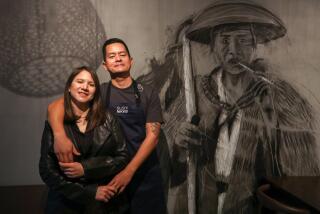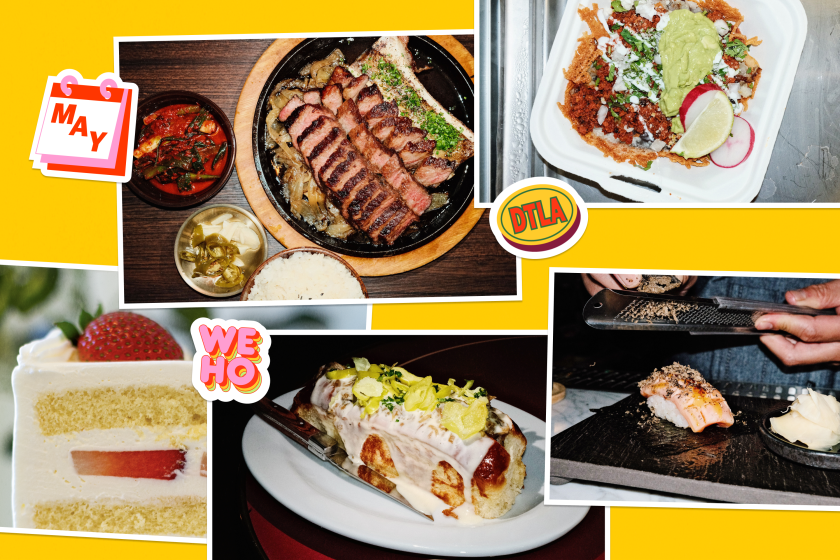Tonight’s Special Is Paper
Deep in the basement of Moto restaurant, owner and executive chef Homaro Cantu is methodically filling medical syringes with 50 cc of chocolate sauce and shooting the mixture into colorful balloons.
Across the way, a sous-chef grabs a plastic foam box filled with liquid nitrogen, the white smoke billowing out. Nearby, another chef carefully feeds sheets of soybean paper into a Canon i560 inkjet printer, printing out pictures of maki rolls.
Cantu’s kitchen has more gear and chemicals than some high school science labs because his goal is to create meals that are so cutting edge they challenge the definition of food.
Cantu’s sushi platter routinely has no fish -- instead it holds squares of tuna-and-rice-flavored paper. The Caesar salad has no lettuce -- only a single spoonful of romaine-flavored ice cream. The menu sometimes is edible and can be crumbled into a bowl of gazpacho -- turning it into an alphabet soup.
All this is included in one of the nation’s most expensive tasting menus: With paired wine, the 20-course meal costs $240 per person.
That’s not counting the tip.
At a time when competition for diners is fierce, a small but growing number of chefs are blazing a strange new trail: creating a dining experience that mixes haute cuisine with extreme science.
In part, the trend comes as a result of the industry’s hypercompetitive nature: About 75% of restaurants close within a year of their debut, the National Restaurant Assn. says.
Moto doesn’t serve traditional meals, where the plate is piled with food. Instead, it offers a series of plates that often hold no more than a mouthful.
Depending on Cantu’s whim, the meal could include pork belly with Kentucky-fried ice cream (tiny scoops of cream that have been altered to taste like crispy chicken skin). Dessert may be birthday cake: Cantu takes a sugary liquid that tastes like cake, and, mixing it with sodium alginate and calcium chloride, turns it into a bite-sized ravioli.
“Cooking is all about technology and having fun with your food,” said Cantu, 28. “We’re here to help gastronomy catch up to the modern age.”
Diners say they are fascinated to interact with their food by tearing up the menu and watching the ink blur with the soup. They puzzle over the sushi paper, which dissolves in a gummy and chewy mess that sticks to the back of their teeth.
Few come simply to be fed.
Q. Phia Dedes, a 28-year-old artist, had read about the restaurant and was intrigued enough to join a friend on a recent Saturday night.
“It’s like conceptual art, isn’t it?” she asked, as a server delivered the first of their 20 courses, the Caesar salad.
“Please, eat this in one bite,” the server said.
It wasn’t tough to do. The bowl held a spoonful of green ice cream, with a solitary crouton on top and a dollop of dressing. Looking nervous, Dedes slipped the spoon into her mouth. The ice cream went down easily, coating her mouth with the fresh, crisp taste of romaine lettuce.
“That’s fantastic!” Dedes said. “What’s next?”
*
Chef Ferran Adria of El Bulli restaurant in Spain is credited with starting the trend. At his laboratory in Barcelona and at his restaurant on the Catalan coast, he and gastronomic experts have spent the last few years consulting on futuristic dishes that range from making carrot-scented mist to figuring out ways to deliver scoops of hot ice cream.
One possibility: An ice cream-flavored liquid is encapsulated in an edible container.
Other chefs have followed.
Heston Blumenthal, who owns the Fat Duck restaurant in England, was recently awarded a $75,000 grant from Britain’s Biotechnology and Biological Sciences Research Council to hone the art of making a crunchy cocktail.
Grant Achatz uses his Chicago kitchen-turned-laboratory at his restaurant Alinea to develop ways to capture concentrated flavors in gas form. For the virtual shrimp cocktail, diners at the recently opened restaurant are given a plastic atomizer and told to spritz their tongue to taste shrimp, horseradish and tomato-flavored air.
It’s a dish that’s more focused on flavor than nutrition.
“But Cantu is out on the fringe, even among those who are considered to be way, way out there,” said food writer Laura Shapiro, author of “Something From the Oven: Reinventing Dinner in 1950s America.”
“Serving paper is about as strange and foreign -- and as far away from actually feeding the soul -- as you can imagine,” Shapiro said.
The culinary community is split on Cantu. The chef said some food critics were reluctant to review his restaurant because they thought his approach was more gimmick than innovation. But many reviews have been positive.
Adventurous diners have helped make him a success. Since Cantu opened Moto in January 2004, curious eaters have headed to Chicago’s meatpacking district to partake in a meal that can stretch for six hours. His most loyal customers fly into Chicago just to eat there -- though they say they often are confused about what they’re paying for.
“You can get a meal anywhere. This is for people who want to think when they eat,” said Joseph Edmundson, an interior design salesman from Rhode Island who regularly comes to Chicago to eat at Moto. “You may not like every course and every taste, but you have to appreciate the artistry.
“I come for the surprise. Besides, I like the sushi [paper],” Edmundson said. “It’s fun and does taste like fish.”
*
Inside the basement of Cantu’s home on Chicago’s North Side, boxes overflow with springs and gears and leftover bits from appliances he has taken apart. Science magazines and computer manuals litter his coffee table.
“That is where I get many of my ideas,” Cantu said.
Cantu was raised in Portland, Ore. His father was a fabricating engineer who made research tools for high-temperature experiments. As a child, Cantu took apart the family lawnmower -- three times -- because he was curious about how combustion engines worked.
“I like to see how things function, and to see if there’s a better way to make them,” Cantu said.
That desire for experimentation led Cantu into the kitchen. He worked at a fast-food restaurant at age 12 to learn how to cook and to pay for electronic gadgets that he stripped down to their gears.
Along the way, he said, he realized that cooking was, at its core, science.
“It is chemistry and physics and biology all wrapped into one,” Cantu said. “What other field can I experiment on something different every single day?”
After high school, Cantu graduated from the Le Cordon Bleu program at the Western Culinary Institute in Portland. For the next five years, he trained at about 50 restaurants.
“I was bored at school and bored in a lot of the kitchens,” Cantu said. “It seemed like all I was doing was putting things into saute pans.”
Cantu moved to Chicago in the late 1990s, drawn by a small but determined pool of chefs who were pushing the boundaries of traditional cooking.
Historically, this would have seemed like a bad move. For decades, Chicago had been known for serving up hearty portions of beef and potatoes.
By the 1970s, high-end French restaurants had opened. Then Charlie Trotter arrived and emerged as one of the city’s first celebrity chefs. He was known for innovation.
In 1999, Cantu landed a job with Trotter and experimented in his kitchen. Cantu left in 2003 to start his own restaurant. When Moto opened, diners initially were confused.
“It was like eating a science experiment,” said Robert Scarola, a friend of Cantu’s and the author of “Make Mine Medium Rare: A Diner’s Survival Guide.” “It was a fringe dining experience. It was dining as a form of art.”
Word traveled in the food and scientific communities about what was happening in Cantu’s kitchen. Artists from New York and biochemists from MIT arrived to dine. Adria, the chef from Spain who launched the trend, sent his brother to eat at Moto -- and to swap ideas.
On a recent night, about two dozen chefs moved through Moto’s kitchen in a nearly silent dance. Only the sound of knives chopping and chemicals bubbling could be heard.
In one corner, Cantu prepared a sauce for one of the evening’s desserts, a mixture of Mexican sweet potato and spiced chocolate.
Cantu gathered balloons to fill with the chocolate sauce. He inflated the balloons with nitrogen gas, then dropped them into the plastic foam container of liquid nitrogen. One by one, he carefully turned the balloons around and around in the liquid nitrogen, which froze the chocolate.
“You have to be a bit careful, otherwise you can really hurt yourself doing this,” Cantu said.
With a few quick slits of a knife, Cantu peeled away the balloon to reveal a perfectly round and hollow ball of chocolate.
Dessert was ready.
His kitchen is filled with tanks of liquid nitrogen and carbon dioxide as well as Cantu’s inventions, some of which he considers classified secrets. He said he had filed for patents on at least 30 of the ideas.
But it’s not enough. Each week he meets with aerospace engineers and software programmers at a Chicago design firm called DeepLabs. They are finishing a prototype of a fork that releases scented gas and a spoon with a self-heating handle that can be filled with soup.
“You tilt the spoon and the soup comes out,” Cantu said.
The point of such inventions eludes many people, including some of Cantu’s family and friends.
Cantu’s wife, Katie McGowan, 35, said she had learned not to leave her husband alone with their electronic items.
During their engagement last year, she assumed that their wedding presents would be safe while she was on a business trip.
She returned to find many of the gifts stripped apart. A cappuccino maker had been sawed in half. It still worked but performed a different function: It generates steam to help spices stick to edible paper.
It now sits in Moto’s kitchen.
*
Each of the restaurant’s 48 seats was full as plate after plate arrived at the table of Dedes, the artist. She nibbled on a mixture called Champagne and King Crab. But there was no alcohol in the dish. The bubbles came from grapes, which were popped into a device that added carbonation to food products. Little bubbles hissed out of the mixture, tickling her tongue.
Sitting at a nearby table, Daniel Walton stared at the fizzing crab and the waiters gliding by with platters of Cantu’s famous sushi-flavored paper.
“You have got to be kidding me,” said Walton, 41, a Los Angeles businessman in town for a conference. “I knew this place was unusual, but this is too much for me.”
Before a server could fill his water glass, he and his date left.
Dedes happily stayed for the entire six-hour meal. But near the end, she waved the waiters away.
“Please, no more,” she said, as the server delivered the chocolate and sweet potato dessert. “It’s been amazing. But I can’t eat another bite.”
More to Read
Eat your way across L.A.
Get our weekly Tasting Notes newsletter for reviews, news and more.
You may occasionally receive promotional content from the Los Angeles Times.






